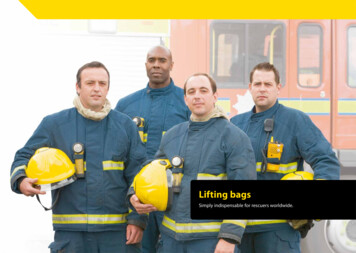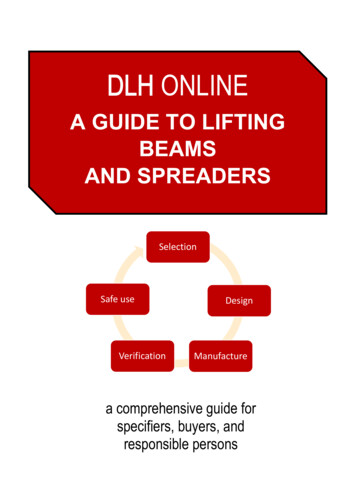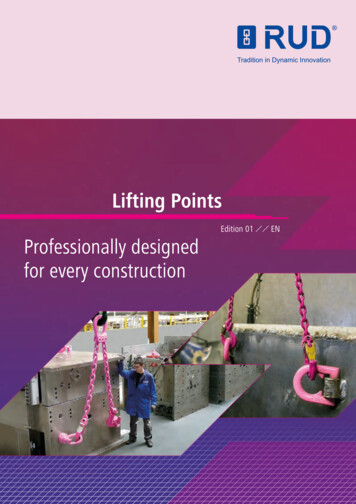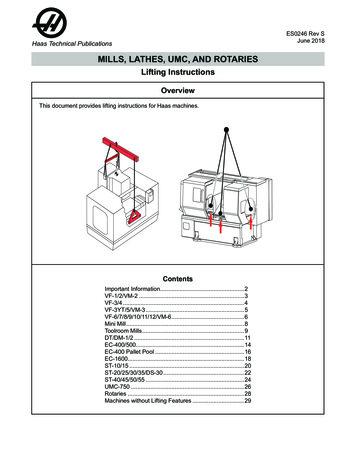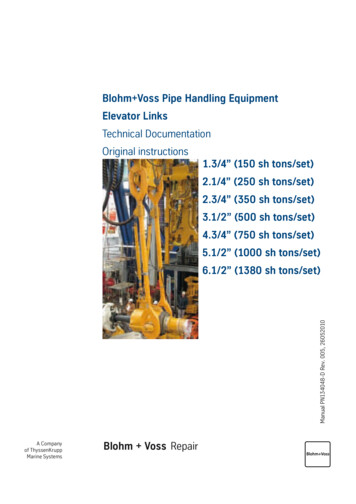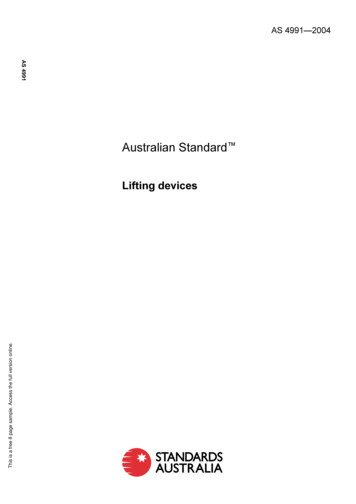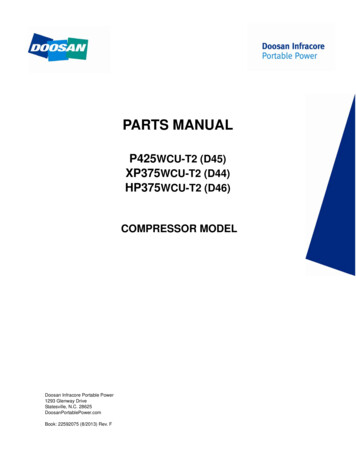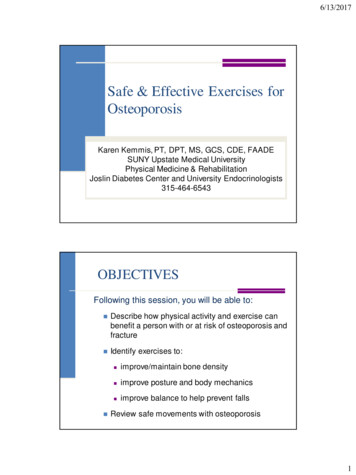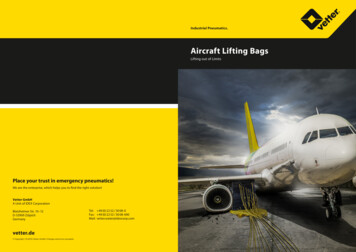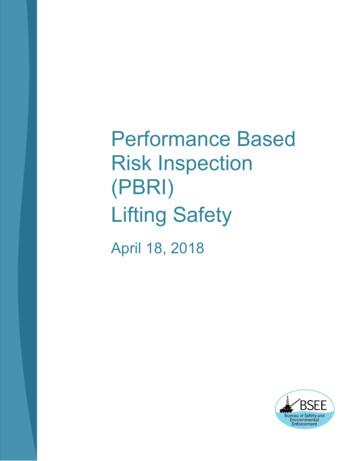
Transcription
Performance BasedRisk Inspection(PBRI)Lifting SafetyApril 18, 2018
Performance Based Risk Inspection (PBRI) – Lifting SafetyPBRI Report1.0General . 22.0PbRi Objectives and Scope . 23.0PBRI Criteria . 23.1Identification of Facilities . 23.2Identification of PBRI Team and Process . 33.3Protocol used in the PBRI . 44.0PbRi fiNDINGS . 45.0PBRI conclusions and Recommendations. 161.0GENERALThe purpose of the Performance Based Risk Inspection (PBRI) is to allow the Bureau of Safety andEnvironmental Enforcement (BSEE) the opportunity to focus on reducing the likelihood of adverse events andcompliance issues across the Gulf of Mexico Region (GOMR).In January 2018, the Office of Safety Management (OSM) met to review the latest compliance and incidentdata to identify any trends Gulf wide. OSM’s review focused on data from 2016 through 2017. The analysispointed to a potential risk associated with cranes and lifting safety. During the timeframe reviewed, 178 craneincidents were reported to BSEE by 30 unique operators. Further, the Agency issued 103 crane-relatedincidents of non-compliance (INCs) during the same timeframe. The operators with the most compliance orperformance issues fed into the proposed facility list, and the top incident factors (procedures,communications, worker qualifications, etc.) fed into the inspection protocol.The PBRI included 30 production platforms and 10 well operations in the GOMR which were operated by 14unique operators. Each BSEE district conducted a minimum of eight inspections between March 13 and 14.One facility inspection was conducted March 19 in conjunction with its previously scheduled annual inspection.The PBRI was a joint exercise with the United States Coast Guard (USCG). The actual inspections accountedfor 819 hours and review of 2,209 files.2.0PBRI OBJECTIVES AND SCOPEThe objectives and scope of the BSEE Lifting Safety PBRI was to conduct a targeted inspection that focusedon recent and specific safety concerns in the GOMR. The PBRI looked past compliance and included protocolto focus on personnel competency, equipment mechanical integrity, and critical portions of an operator’s safetyand environmental management system (SEMs).3.0PBRI CRITERIA3.1Identification of FacilitiesThe BSEE Office of Offshore Regulatory Programs provided the GOMR a copy of the latest Argonne NationalLab (ANL) Risk Model for every production facility in the GOMR on Jan. 25, 2018. OSM compiled a list offacilities and operators who had specific crane-related incidents or compliance issues from 2016 through 2017in each District of the Gulf. Following our analysis, OSM compared their field verified data2
District1 ‐ NO1 ‐ NO1 ‐ NO1 ‐ NO1 ‐ NO1 ‐ NO1 ‐ NO1 ‐ NO2 ‐ HO2 ‐ HO2 ‐ HO2 ‐ HO2 ‐ HO2 ‐ HO2 ‐ HO2 ‐ HO3 ‐ LF3 ‐ LF3 ‐ LF3 ‐ LF3 ‐ LF3 ‐ LF3 ‐ LF3 ‐ LF4 ‐ LJ4 ‐ LJ4 ‐ LJ4 ‐ LJ4 ‐ LJ4 ‐ LJ4 ‐ LJ4 ‐ LJ5 ‐ LC5 ‐ LC5 ‐ LC5 ‐ LC5 ‐ LC5 ‐ LC5 ‐ LC5 ‐ LC3.2Facility NameEW 305 ASP 60 ASP 93 BVK 786 A - PetroniusWD 29 AWD 109 ANabors MODS 201Thunderhorse PDQEW 826 AGC 65 BullwinkleGC 680 ConstitutionGC 787 AtlantisSS 189 ASS 219 ADiamond BlacklionH&P 107EI 175 DGB 260 BaldpateSM 69 BSM 130 ASM 236 ASM 239 DH&P 406Noble Paul RomanoBA 105 AEB 160 A CervezaEB 643 A BoomvangHI A582 CHI A443 AHI A472 AT.O. Deepwater PontusNon-Rig PA HI 531VR 131 CFVR 164 AVR 245 C-DRILLVR 261 A / A-AUXVR 265 A-DRL / A-PRDVR 369 AWireline - VR 331Spartan 208OperatorTalos Energy OffshoreFieldwood Energy OffshoreEnergy XXI GOM, LLCChevron USA Inc.Energy XXI GOM, LLCCox Operating, LLCW&T EnergyBP Exploration and ProductionFieldwood Energy OffshoreFieldwood Energy OffshoreAnadarko Petroleum CorpBP Exploration and ProductionFieldwood Energy OffshoreRenaissance Offshore, LLCHess CorporationW&T Offshore IncFieldwood Energy OffshoreHess CorporationANKOR Energy LLCEnergy Resource Tech (Talos)Cox Operating, LLCEnergy XXI GOM, LLCShell Offshore IncHess CorporationFieldwood Energy OffshoreFieldwood Energy OffshoreAnadarko Petroleum CorpCox Operating, LLCNorthstar Offshore GroupEnergy XXI GOM, LLCShell Offshore IncMcMoran Oil and GasTalos Energy OffshoreEnergy XXI GOM, LLCCox Operating, LLCFieldwood Energy LLCFieldwood Energy LLCRenaissance Offshore, LLCEnergy Resource Tech (Talos)Cox Operating, 239426216105160643A582A443A472728A 531131164245261265369331245Complex entification of PBRI Team and ProcessThe District Field Operations Regional Supervisor sent a memo on Feb. 16, 2018, informing all districts ofmandatory training for all personnel involved in the PBRI.OSM facilitated three training sessions with regional, district, and USCG personnel assigned to conduct thePBRI. The training provided guidance on the inspection protocol and how to access GOM Region electronicfiles for facility specific documentation. This training was attended by over 80 people.All PBRI inspectors were instructed to complete every Performance Based item on the inspection form and 50percent of the crane PINCs applicable to the facility type. Each inspection was documented as an “Audit orOther Special Inspection.” All documentation and paperwork was forwarded by the districts to OSM by March23 to conduct analysis. OSM performed 20 in-depth reviews of the PBRI facilities – 15 production facilities andfive drilling units.BSEE and USCG inspectors were also instructed to test the effectiveness of operators’ SEMS by witnessingthe application of safety management principles/processes applied to ongoing operations, further evaluatingthe operators’ understanding of risk and critical risk management principles associated with lifting safety.3
3.3Protocol used in the PBRIThe protocol used in this PBRI included review of records, policies, procedures, forms, onsite interviews withrelevant staff and contractor personnel, and Quality Assurance / Mechanical Integrity SEMS element materialsas applicable.Each completed form was scanned and uploaded to the appropriate electronic folder on the BSEE GOMRserver to document the inspection.4.0PBRI FINDINGSAt the completion of the inspections, OSM engineers and SEMS specialists reviewed the results supplied bythe districts and conducted additional reviews on SEMS specific items – e.g., crane inspection (preuse,monthly, quarterly, and/or annual) records, lifting Safe Work Practices, competency of riggers and craneoperators, maintenance of lifting equipment (slings, rigging components, etc.), JSAs, etc. The findings are:1. Noncompliance with Regulations – 12.5 percent of the facilities involved in the PBRI had documentedincidents of noncompliance. These facilities failed to meet the minimum requirements of BSEE or USCGregulations. For example:a. Facility was issued an I-116 PINC. At the time of inspection, the anti - two block on the load line ofthe West Crane did not operate as designed. Note: The anti -two block is installed but did notperform its design function. The load line must be placed out of service until repaired. As a result ofthis inspection, the facility remained on BSEE’s increased oversight list.b. Facility was issued a G-112 PINC. At the time of inspection, all work areas were not maintained in asafe condition: 1) trash and debris found on the decks, 2) items not properly stored 3) rope andother trip hazards in walkways. Facility was issued a G-111 PINC. At the time of inspection, thehandrails near the top of the crane access ladder were corroded. Facility was issued an I-102 PINC.There were two lifts made outside of the restrictions of the currently down-rated load chart. Theload chart indicated that the maximum distance for onboard lifts was 60 ft. The conex box#M6070002, weighing 4500 lbs., was approximately 65.5 ft. from the center of the crane pedestaland a cargo basket measuring 4X8 ft., weighing 1500 lbs., was approximately 63ft. from the centerof the crane pedestal.c. Facility was issued an I-145 PINC. At time of inspection, operator did not complete requiredquarterly inspection on Crane A (HSMC370 / Serial No. 424).d. Facility was issued an I-105 PINC. At the time of the BSEE Inspection, the following was found on APlatform: crane a bolt was missing from the boom heel section. Repaired at time of the inspection;Facility was issued an I-141 PINC. At the time of the BSEE Inspection the following was found on APlatform: Lack of grease, load sensor had no oil, missing and cracked glass, diesel hose cracked. DPlatform: cracked and missing glass, missing door, back glass has paint over spray. G Platform:missing and broken glass; Facility was issued an I-147 PINC. At the time of the BSEE Inspection thefollowing was found on G Platform: crane on the main hoist line needed to be re-spooled.4
Repaired at the time of the inspection; Facility was issued an I-153 PINC. At the time of the BSEEInspection the following was found; On D Platform boom lattice rusted thru in two areas; Facilitywas issued an I-182PINC. At the time of the BSEE Inspection the operator did not have the properCrane Operator Qualification Card.e. USCG shut in both of the jack-up rig’s gantry cranes (approved for personnel lifting) On bothcranes, the winches were recently replaced and the vessel failed to provide required recordsproving load test prior to use. Other issues were failed cotter retaining pins on the auxiliary lineoverhaul balls of both gantry cranes, bird-caged/crushed wire rope at wedge socket on one gantrycrane, and worn hydraulic and fuel lines. Additionally, several probable electrical and watertightintegrity issues were identified warranting follow up.Bolt was missing from the boom heel section on platform craneHandrails near the top of the crane access ladder corroded5
Failed cotter retaining pins on the auxiliary line overhaul balls of both gantry cranes2. API Spec 2D Crane Inspections – PBRI teams reviewed the operator’s latest inspection reports on all cranesat the subject facilities (pre-use, monthly, quarterly, and/or annual). BSEE was able to determineoperators are conducting crane inspections in accordance with API Spec 2D; however, evidencesuggested that the inspections are not effective and/or operators are not aggressively closing out noteddeficiencies.a. During the inspection, the crane was placed out of service for corrosion on two lacings in the centerboom section. No issue(s) identified on monthly inspection conducted on 3/1/18, quarterlyinspection conducted on 1/8/18, or annual inspection conducted on 7/4/17.b. Both north and south cranes had heavy lift inspections performed around the time of inspection,where corrosion, bent/holes in lacing, leaks from gear box/hydraulic/fuel hoses were identified.Both north and south cranes had follow up inspections within the following month that showedthat the conditions had worsened over time. Very little progress was made to correct any issuesidentified in the heavy lift inspections. (i.e. corrosion had evolved to excessive corrosion,recommended painting had evolved to requiring painting, etc.) .c. A moderate number of deficiencies (frozen jibs, corroded fuel lines, leaking hydraulic filters, etc.)were identified on both cranes in their annual inspections, but it appears that personnel areprioritizing and addressing them appropriately. Additionally, BSEE inspectors identified a cuthandrail on the west crane. The handrail was found blocked off with a steel cable, and personnelstated that a more permanent fix would be welded in the near future. The missing handrail isn'tadjacent to a walkway or in an area of the crane frequented by personnel, so it isn't a serious safetyhazard. However, it is concerning that none of the personnel interviewed knew exactly why orwhen it got cut, or by whom.d. Quarterly Inspection (FEB 2018) Serial NO. 4383 show deficiencies of corrosion on boom, minorleak on hoist gearbox, and minor corrosion on thrust walk. Annual inspection (SEPT 2017) SerialNO. 4383 shows deficiencies of corrosion on boom, damaged hydraulic hoses, boom light is out,gantry warning light is damaged, boom cable and main cable need lube, minor corrosion on heatexchanger. Quarterly Inspection (FEB 2018) Serial NO. 4382 shows multiple deficiencies and thecorrection date for the deficiencies on inspection form.e. The crane was recently de-rated for boom hoist material loss. Current load chart showing de-ratingindicates no personnel capacity. Annual inspection report notes that neither the auxiliary line6
f.g.h.i.j.k.l.m.n.o.p.block/ball nor the main line block/ball has a certification on file. "Second mid-section of boom isinstalled upside down."Inspector noted discrepancy list on crane inspection report. February Crane Winch Inspection notesundefined 2/18/2018 deficiency pending.Maintenance records during the time of the annual inspection are not associated with the finalannual inspection report even though deficiencies with the crane were corrected. Anti-two blockdevice failed nine days after Annual Inspection date.SWP require pre-use, quarterly, semi-annual, and annual inspections of winches for infrequent usecranes. Operator could not provide these inspections and was conducting work outside of SWP.Crane ball markings were painted over, but paint was removed prior to the end of the inspection.Possible inconsistencies in how the crane certification and classification restrictions are managed.No evidence of deficiencies on annual inspection or record of any deficiency corrections. This isconsistent with other locations in that the inspections are suspect in their effectiveness andthoroughness.Parts on order for a Bow Crane non-working boom angle indicator as of 12/31/2017. Still activeorder and parts have not been replaced. Considered “low” priority. Barge engineer remembersperforming calibration of load indicator as he was the person on board, but the last annualinspection does not have documentation and the inspecting company is no longer in operation.Quarterly crane inspection DOES have associated deficiencies.Multiple crane discrepancies were noted including broken retainer pins, gouged hydraulic lines,leaks, data plates missing from ball on fast lines, cracks in glass, oil accumulations in skids. Whilemultiple inspections were performed, these items were NOT identified as deficient or as a problemand rig contractor cannot provide an explanation or reason for this.Annual inspection report notes that the front crash bar keeper roll bar on West Crane is broken onone side and needs to be welded back into place. Load chart in crane did not show correct wirerope size on main hoist. Numbers are faded on angle indicator.1/12/18 Quarterly Inspection Report indicated that "all hydraulic hoses are in rough shape withthe rubber material dry rotting and cracking and fittings rusting very badly." No previous monthlyinspection notes made any note of this.There was severe corrosion on the engine covering. At the time of the inspection, it was not animmediate safety hazard, but it needs to be addressed in the near future. This corrosion was notedon the previous three crane inspections. There are missing pages in the annual and quarterlyinspections. Both lack page two of the reports.Load chart for Pedestal Crane 700 is marked as "old chart do not use." At the time of inspection,operator did not complete required quarterly inspection on Crane A (HSMC370 / Ser# 424).7
Severe corrosion on the engine coveringLoad chart showing de-rating of crane 6 days prior to inspection8
Numbers are faded on angle indicator3. Lifting Equipment Maintenance – BSEE requested the operator provide a register (maintenance tracking) inplace for the lifting equipment at the facility, and asked if there was a dedicated person on the facility whowas responsible for monitoring and updating the maintenance. During the Lifting Safety PBRI, BSEEinspectors were able to conclude that a majority of the operators subjected to the inspection had noprocess for following the manufacturer’s recommendations for preventative maintenance, trackmaintenance records, or to schedule and regularly replace lifting equipment (slings, components, etc.).a. Operator had no unique ID to track maintenance of lifting equipment (slings, components, etc.).b. Facility could not provide a maintenance tracker for lifting equipment. No dedicated person onfacility to update.c. No tracking system for lifting equipment or slings. "During pre-use inspection, all crane operatorshave the responsibility to inspect all lifting equipment (including slings/straps) and they also havethe authority to order out replacement equipment at any time equipment is found deficient. Oldslings/straps are cut up and discarded to not be used again."d. Lifting equipment is marked with a rated limit and the manufacturer, but the serial number and theinspection date were not predominantly visible. Lifting equipment storage was not organized well,and it had abrasive wires contacting nylon straps.e. Response to request for maintenance tracking/register resulted in one vague work order frompersonnel on the facility.f. No maintenance tracking register for lifting equipment. Personnel only inspect lifting equipmentprior to each use. Operator could not produce a Maintenance Tracking System for slings / liftingequipment.g. No separate system/inventory/forms for tracking lifting equipment maintenance: In practice,provisions for lifting equipment inspections are included within the operator crane monthly andpre-use inspection forms. Prior to each use, the crane and lifting equipment are inspected (item#13 on the pre-use inspection checklist). Additionally, the last section of the Monthly InspectionForm “General/Operations” includes a check of the lifting equipment. These processes include9
h.i.j.k.l.visual inspections of the equipment and verification of the tags on slings to determine compliancewith the replacement interval. Most recent monthly and weekly sling inspections consisted of hardcopies from the year 2008.There is a maintenance tracking system, but there is no dedicated person on the facility responsiblefor monitoring and updating the register.During PBRI, one cable sling was put out of service because there was no tag to identify sling andhow long it had been in service.Safety clips were found broken and/or deteriorated. Maintenance Work Order tracking sheet isvery organized and covers Class A20 (engine, winches, crane, etc.) as well as Class A15 and ClassA65. Tracking sheet is from January 2017 to March 2018.Lessee recertifies slings on an annual basis. They have a usage log book that stays in the sling boxfor the life of the sling.Organization of lifting gear is commendable, and the cranes are "meticulously maintained."Commendable, "meticulously maintained" equipment maintenanceAbrasive wires contacting nylon straps in storage container4. Load Indicating System – During the PBRI, BSEE inspectors verified if operators had functioning loadindicating systems and when they were last calibrated. Twenty percent of the facilities inspected duringthe PBRI had no load-indicating system in place, or it had no available record(s) of calibration.a. No load-indicating system installed on crane.10
b. Has a functioning load-indicating system but it is not calibrated. Always follow the load weightsposted on equipment and manifest.c. No load-indicating system installed on crane.d. Crane does not have a functioning load-indicating systeme. No load-indicating system installed on crane.f. Unknown when last calibration was performed for load-indicating system.g. Crane load indicator was recently not zeroing out, meaning that it showed 700 lbs when there wasno weight on it.h. Weight indicator calibration could not be located at the time of the inspection.Crane Load Indicator with unknown calibration5. Tag Lines – During the PBRI, BSEE inspectors reviewed the taglines in use at the facilities and tried toevaluate the Operator’s Safe Work Practices associated with their use. The inspections suggest thatOperators Safe Work Practices (SWP) with tag lines, are not implemented specific to line length/strengthrequirements, or personnel are not familiar with those that exist.a. Tag lines included in operator's Safe Work Practices; however, there is no mention of line length orstrength requirements.b. Tag line policy states "shall be used on all lifts. They shall be of sufficient length, diameter, andstrength to allow adequate control of the load by the rigger(s).All loads shall contain a tag line ofproper length." Length was defined as a minimum of 15 ft., but diameter and strength were notdefined.c. Operator has a tag line policy, but crane operator was unaware of it.d. The Offshore Installation Manager is unaware of a written tag line policy but thinks that theCrane/Lifting Program is currently under revision to include tag lines. It should be noted their SafeWork Practice on lifting was revised two weeks prior to the PBRI inspections and BSEErepresentatives were told on site that the operator knew the approximate date of the inspection.e. Taglines policy in place, but no information on length, size, or strength of taglines.11
f. Lifting policy does not specifically have a procedure on tag line use. Upon inspection of the taglines, two tag lines had clips/carabiners with sticky/unsuitable components. The tag lines wereimmediately taken out of service to be worked on, fixed, or quarantined if they cannot be replaced.g. Tag line policy is in place "They shall be of sufficient length, diameter, and strength to allowadequate control of the load." Yet, the appropriate diameter and strength are not defined.h. There is no written tag line policy.i. Tag lines are within Safe Work Practices Manual but don't describe the size or length requirements.j. Person In Charge (PIC) was not familiar with the dimension requirements for the tag lines (i.e.minimum length of 15 ft.).Tag line in use at subject facility6. Training and Competency – Overall, training documents were readily available to BSEE inspectors duringthe inspections to verify minimum requirements were being met; however, there was a noticeable gapon the determination of a crane operator, crane inspector, or rigger’s competency after training.a. Does not seem to be a policy in place to determine competency of crane ops/riggers beyondtraining certifications.b. No policy to verify competency of crane operator beyond training certificate.c. Competency is verified by experience and comfort level of the crane operator. No formal policy oncrane competency.d. Received Crane Operator Competency (Hands on Proficiency), but the documents were createdand completed 3/27/2018 – after the PBRI. BSEE Office of Safety Management Sample Auditrequest to operator was sent on 3/26/2018. Did not receive documented evidence prior to thisdate. Crane Lifting Procedures were revised on 3/27/2018 to include these competencyassessments.e. No competency verification outside of checking certificates. New crane operators have to besupervised by “qualified crane operators.”f. Operator provided Crane Qualification Cards based on their Crane Policy Section 8.3.3 which states"A test and a hands-on evaluation of each candidate's operating proficiency shall be administered12
by an approved qualified instructor on the type of crane (hydraulic, mechanical, or both) to beoperated by that candidate. Based on the results of the hands-on evaluation, operator experienceand classroom test results, the operator will be classified as follows: "There's no revalidation periodstated in policy, and one card was last issued 4/12/2011.g. Crane operators have inconsistent certifications. Some have an operator’s classification card andother don’t. Possible inconsistencies in how the crane certification and classification restrictions aremanaged. This was no crane certification information for the main crane task supervisor or subjectmatter expert.h. Crane Operations Personnel Safety Manual has a section for Crane Operator competencyevaluations, but no sample evidence of completion could be provided to BSEE.i. Employee’s rigging certification was expired as of 11/15/2017. Furthermore, no training certs ofthe crane operators on the approved list were provided to BSEE.j. One crane operator on B crew had an expired simulator certificate. Expired on 2/18/18.k. On multiple JSAs, there is a job step for a responsible person to verify crane operation is qualifiedfor planned lifts by ensuring the crane operator has valid API Certificate; however, at the time ofthe inspection, BSEE identified an employee making lifts who did not have the certifications to passbut the JSA was signed and acted on.7. Lifting Communication – BSEE identified multiple facilities which lacked evidence to support personnelwere knowledgeable of proper lifting signals referenced in API RP 2D. A few examples of these gaps are:a. There was inconsistency with hand signal knowledge. Each person demonstrated a different signalfor Stop Work Authority (SWA). There was also inconsistency in the number of signal personsreported: PIC stated that there can only be one; the crane operator said that there may bemultiple. Contractor recommended hand signals are different from what is posted on the craneitself. Both of these are even different from the operator’s signals (correct) provided in the CraneHandling Procedures. The signals in the Contractor’s document and the placard in the crane cabare using incorrect "emergency stop" signals.b. Hand signal display in cab has tape covering some signals.c. Crane operators exhibited an understanding of the hand signals; however, the OIM failed toexecute the SWA hand signal correctly.d. The SWP manuals for QPM and operator illustrate conflicting crane signals. Some of the operator’ssignals do not even appear in the QPM Safe Work Practices.e. Emergency Stop signal posted on crane differs from current API requirements.f. There is some room for improvement in hand signal knowledge/consistency. When interviewingthe crane operators separately, they had different signals for all stop/emergency signaling.13
Outdated Placard on crane8. Personnel Transfer – BSEE identified multiple facilities and operators which lacked personnel transferprocedures, specifically those that covered weather and sea conditions. A few examples of these gapsare:a. PIC stated that there is no personnel transfer procedure or specific personnel transfer training.b. Operator and contractor have no predefined criteria for personnel lifts - seas states, wind speeds,etc.c. There is no specific personnel transfer training. If it is someone's first time to ride in a personnelbasket, they are instructed on the boat.d. All Operator Facilities - Operator has no predefined criteria for personnel lifts - seas states, windspeeds, etc.e. All Operator Facilities - Operator has no predefined criteria for personnel lifts - seas states, windspeeds, etc.f. Despite having no plans to use it in the future, the operator’s personnel transfer basket was leftexposed to sunlight on the deck. Recommended to operator to store it in a location shielded fromdirect sunlight.g. Operator has a policy with weather considerations that align with 29 CFR 1926.1431(k)(8)(i) – thepolicy includes a determination made by qualified person when wind speed exceeds 20 mph.h. There is no paperwork documenting personnel basket inspection; however, the basket is less thana year old.9. Hazard Communication – During the PBRI, BSEE identified multiple facilities and operators which lackedevidence to support companies informing offshore personnel of the circumstances surrounding anaccident or near miss release by BSEE. A few examples of these gaps are:a. Safety alert information was not transferred over to the other hitch. Once the first crew receivesthe safety alert notification email, they review it, but they don't post it on their bulletin board forthe next crew to get exposure to it.b. Consider improving the distribution of safety alerts and bulletins. Some address specific issues, somore focused communications may be appropriate. The field coordinator wasn’t familiar with the14
c.d.e.f.g.h.recent BSEE Safety Alert No. 329 on crane incidents and wanted to be included in futurecommunications.Operator not familiar with Safety Alert #329, operator was provided with a copy at the close ofinspection.Personnel were not aware of Safety Alert # 329. People on opposite 14/14 hitch do not hear aboutwhat was received.Facility was not familiar with Safety Alert #329. Safety Alerts are supposed to be sent to fieldlocations by management.Safety Alert #329 was discussed at facility when it first was issued. No changes were made as aresult of it, jut instructed to bring it up at the next safety
At time of inspection, operator did not complete required quarterly inspection on Crane A (HSMC370 / Serial No. 424). d. Facility was issued an I-105 PINC. At the time of the BSEE Inspection, the following was found on A Platform: crane a bolt was missing from the boom heel section. Repaired at time of the inspection;

